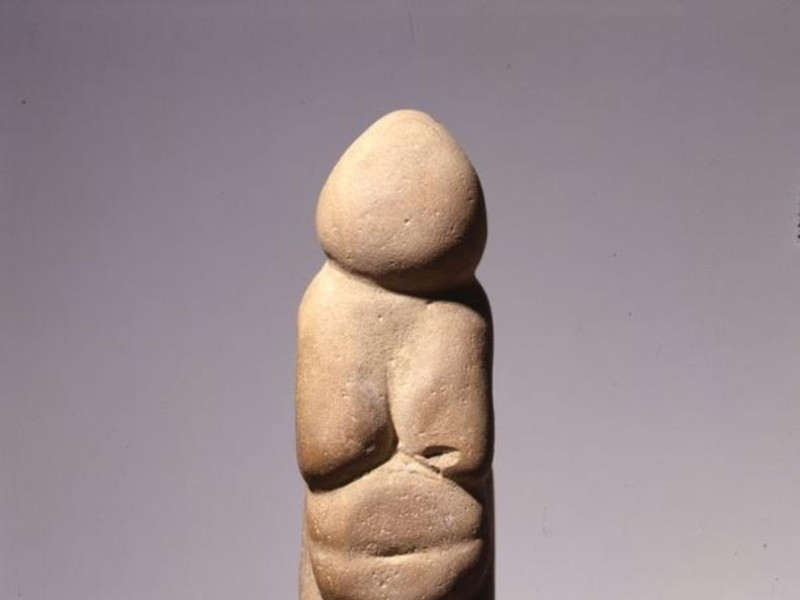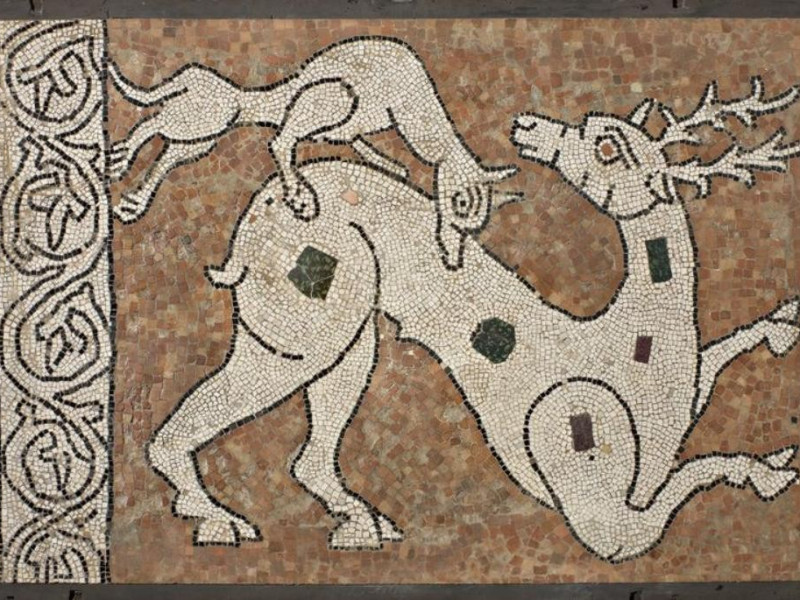Musei civici - Palazzo San Francesco
Historic core of the collections of the set up in the old convent of Minor Friars of St. Francis, originates from the collection of the scientist Lazzaro Spallanzani (Scandiano 1729 - Pavia 1799), acquired by the city of Reggio Emilia after the death of scientist and placed, in 1830, in the north wing of the palace, once the seat of the Local High School. With subsequent acquisitions, which have expanded the original core, the Museums now form an interesting unit, divided into various sections and specifications. There are collections of archeology (Museum Chierici, Portico dei Marmi - Roman section and Museum of Prehistory), ethnography, history of art (Fontanesi Gallery, Gallery of the marble-medieval section, medieval mosaics), natural history (Spallanzani Collection and zoological, anatomical, botanical, geo-mineralogical and paleontological collections) and history of the city.
• Spallanzani Collection reflects the variety of interests of the scientist in various fields of natural history. Originally distributed in the home of the family, in Scandiano, including zoological, with particular reference to marine life, fossils, minerals and artifacts lithological, largely the result of the collections made by the scholar during his many travels. These scientific findings are combined with personal items of furniture, including memories of the trip to Turkey, a rare game of checkers in amber, alabaster vases, small sculptures, ornaments made with shells, zoological tables and furniture in different variety of marbles. All objects that are, in their diversity and individuality, an interesting reminder of the culture of the late wunderkammern. The current exhibition is the work of Alfredo Jona (1846-1929) who, in the late nineteenth, ordered and classified according to the original core set taxonomic linneani. In this arrangement the collection eighteenth century was clearly distinct from the materials acquired during the nineteenth century, when the destination museum gradually expanded to the entire first floor of the building, accepting extensions of natural history collections, ethnographic and archaeological finds of the Museum of History Patria, founded in 1862 by Don Gaetano Chierici. The naturalistic collections are completed by the zoological collections on display in the dining Vallisneri, including a systematic section and one dedicated to local wildlife, as well as exotic specimens from Collection Franchetti. These include the large collection of the agronomist filippo Re (1763-1817), about eight thousand specimens and herbaria Bertolini (early nineteenth century) and Cramona Casoli (sec.XX). The earth sciences are dedicated two rooms in which it dealt with the theme of the geology in the area of Reggio. In the windows dedicated to Reggiani scientists finally exhibits personal physician and naturalist Antonio Vallisneri (1661-1730), the naturalist Bonaventura Corti (1729-1813) and the physical Leopoldo Nobili (1784-1835).
• Fontanesi Gallery, established in 1902 and reorganized in 1977, reproduces the evolution of the figurative local art through a large exhibition of paintings from the fourteenth to the nineteenth century. Introduces the exhibition an important group of Reggiani frescoes, producted between the fourteenth and fifteenth and sixteenth, some tables of Giovanni Socino and Nicolò Patarazzi. In the second room, dedicated to the artistic culture of Ghiara, there are paintings by Lorenzo Franchi, Alessandro Tiarini, Luca Ferrari, Carlo Bononi, and an important collection of works by Paolo Emilio Besenzi, among the most significant representatives of the local production of the seventeenth century. Below, in the third room, paintings by Francesco Viacava, Felice Boselli, Francesco Vellani, Gaetano Gandolfi and Fra Stefano da Carpi. The modern section includes, for the nineteenth century, works by Prospero Minghetti, Antonio Fontanesi, Alfonso and Gaetano Chierici, Alessandro Prampolini, Lazzaro Pasini and Cyril Manicardi; Augusto Mussini, Ottorino Davoli and John Costetti represent the first decades of the next century.
• Museum Mazzacurati opened in 1995, essentially collects the works of Renato Marino Mazzacurati (1907-1969) donated by Carla Marzi to the City in 1974. The artist, a native of San Venanzio of Galliera, began his studies in Venice continuing them in Rome, where founded the magazine of art and literature 'Front', frequented by Scipione, Carra, Ungaretti. Remarkable then his work as a painter of the Resistance. The path of his work painting and sculpture is held by the figurative tendencies of the Roman school experience cubist and abstract works, until accession to the informal sixties. Also, are preserved works by Fausto Melotti, Graziano Pompili, Gabriele Giorgi and Christian Cassar.
• Roman Museum brings together the findings from Roman found during the excavations undertaken in the fifties in the center of Reggio, under the supervision of Mario Degani. In 1975 the collection was organized by Giancarlo Ambrosetti in provisional archaeological section, completed between 1997 and 1998 in setting the final, according to a thematic order. In the first room stand a fragmentary slab alluding to an important public work commissioned by the Emperor Vespasian, and an interesting mosaic floor from a domus of Via San Carlo. Below samples of wine amphorae and olive oil and pottery household with fragments of statuary placed on the doorposts of access to the second room. The exhibition continues with an epigraphic section and one dedicated to the cults: fragments of sculptures depicting gods alternate with decorative elements for gardens and homes and funeral portraits, including a valuable stela from the necropolis of St. Maurice. Residential construction refer wall decorations and polychrome marble architectural fragments; the theme of hydraulics is illustrated by fistulae in lead and clay tubules. The exhibition continues in the second room with the section of numismatics, inaugurated in 1997. Formed after bequests and donations (Ferretti, Siliprandi, Balletti, Ferrari), this core collects the ingots from Campegine, the treasure of the Roman Republican Borzano, golden imperial bronzes. Since 1957 has exposed the Roman-Barbarian treasure found in the city center. The exhibition is completed with a section dedicated to Christian and early medieval.
• Gallery of Marbels, wanted by Gaetano Chierici in 1875, is housed in the porch of the Cloister of St. Francis. There are exposed over two hundred Romans pieces : tombstones, memorials, statues of various characters, urns, architectural fragments, altars, mostly dating from the early imperial from Brescello, Goleto Boretto, San Maurizio and Reggio Emilia. The materials from the Middle Ages to the eighteenth century instead amounted to about three hundred and fifty specimens, including tombstones, sculptures, columns and capitals. Among the most interesting works are reported a "Madonna with Child" from the second half of the thirteenth century, the baptismal font with the symbols of the Evangelists, the end of the Thousand and portal building Fontanelli, attributed to Bartolomeo Spani (1517), author of a series of marble sculptures from the church of St. James the Great. Prospero Sogari, said "The Clement", a font is already in the oratory of the Visitation of the Virgin Mary. On the walls of the vestibule and atrium align important floor mosaics, dating to the early Roman Empire and the eleventh to twelfth century, from four churches of Reggio: St. James the Great, St. Prosper, St. Thomas and the Duomo. The cycle, collected between 1874 and 1919 by Chierici and Naborre Campanini, documents with pieces of relevant consistency and quality the era of full recovery of urban functions, with the revival of the agricultural economy and the demographic development.
• Museum Chierici was the original core of the Museum of National History formed in 1862 by Don Gaetano Chierici (1819-1886), founder of the Italian paletnologica school. Fully restored in 1975, under the laws initiated by clerics, recognized in the late nineteenth century as a model of scientific method, the collection appears a fundamental document of museological culture, expressed in the chronological classification of the findings gathered in certain geographic areas and stratigraphic sequences. The exhibition, divided into three series, a distrectual and two strangers, shares in a series of 115 showcases materials from Neolithic, Copper Age, Bronze Age, Iron Age and the Roman era, documented by material from the cemeteries around Brescello, and the Barbaric age, represented by kits from Lombard tombs. Of great interest, the finds from Clerics in Ca' di Marco, in caves of Pianosa and the sites of Bellanda and Demorta, stratigraphic surveys of land made during excavations and a number of tombs of the Copper and iron, from Remedello and San Polo d'Enza, fully removed with the bed of land belonging. Then, come the ethnographic materials of North America, collected by Antonio Spagni (1809-1876), who donated them to the city of Reggio in 1844. Accompanying the exposure, the archaeological map of the distrects of Reggio and memorabilia documenting also the political commitment Chierici in favor of the Unification of Italy.
• Prehistoric and Protohistoric Collection is inaugurated in 1975 and, designed by Giancarlo Ambrosetti, includes artifacts found predominantly in the Apennine Reggiano foothills, ranked according to the conventional chronological periodization: the Paleolithic, Mesolithic and Neolithic, documented by important finds, including the famous lithic Venus from Chiozza Scandiano. Some terremare represent the Bronze Age: Cavazzoli, Torretta, Case Cocconi. The remaining cases are dedicated to the places connected to the terramaricolo world located on the reliefs: Castetto, Felina, Torlonia di Sopra and Campo Pianelli, attended the Bronze Age and represented by a significant choice of ossuaries and funerary. In the Museum are also buccheros, purified with decorative bands, Attic pottery, bronze artifacts and Etruscan inscriptions (VI-V century BC). Noteworthy are two Etruscans memorial stones, found at Rubiera, one of which is decorated with geometric elements and zoomorphic figures, bears a funerary inscription dedicated to a magistrate lived in a place called Sala. Following the documentation of the Hellenistic period, relevant to small burial grounds relating to the Ligurian Eastern, with ossuaries within lytic cassette found in Roncolo and Bosco Cernaieto.
• Museum of Industrial Art: in 1877 Gaetano Chierici had exhibited in the final five windows of the Museum of National History a section of medieval and Renaissance decorative arts locally. In this first group of objects, there were some of which came from the Archives of the Secret City, were added important materials and documents on the development of the Art of silk from 1673, collected by Naborre Campanini. In 1904 the Museum of Industrial Arts opened its doors to the north wing of the atrium; in 1974 was restated in the Galleria Fontanesi and again ordered. Among the most significant pieces of the collection, is reminiscent of the wooden model of the Cathedral of Reggio, performed by Prospero Sogari, and automata clock of the Town Hall. Following groups plastic clay, metals, measuring instruments, armor and weapons, jewelery, wood, leather, textiles and accessories. Particularly rich is the numismatic collection, including coins, medals and punches, and that of ceramics, Italian, Iranian Eastern and Chinese, the latter in the legacy of the Minister Pansa Sanford along with bronzes and paintings on silk.







